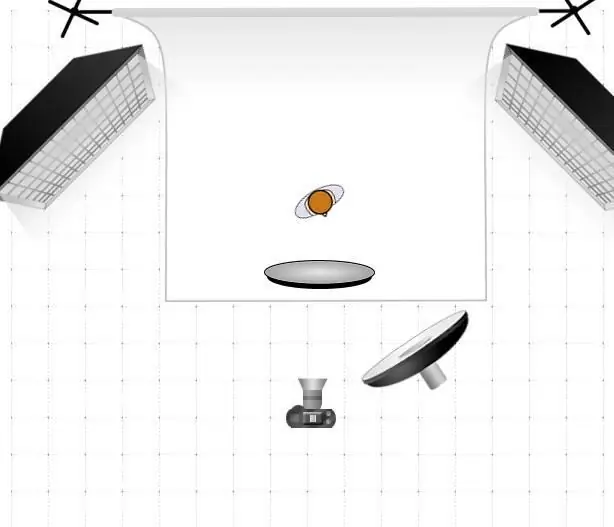
Inhaltsverzeichnis:
- Autor Sierra Becker [email protected].
- Public 2024-02-26 04:43.
- Zuletzt bearbeitet 2025-06-01 05:43.
Profifotografen wissen sehr gut, dass einer der wichtigsten Punkte für die perfekte Aufnahme das gut platzierte Licht ist. Auch bei Outdoor-Shootings haben Fotografen Reflektoren und Schirme dabei, mit denen sie das Maximum an Sonnenlicht auf das Model lenken können. Aber wenn es um Studiobeleuchtung geht, werden die Dinge viel ernster.
Kleine Einführung
Studiobeleuchtungsschemata sind eine ganze Wissenschaft. Natürlich gibt es einige Vorlagen, mit denen Anfänger arbeiten - unerfahrene Fotografen verwenden sie oft für Familien- oder Portrait-Fotoshootings, zum Beispiel für einen Reisepass. Ein erfahrener, talentierter und professioneller Fotograf wird immer improvisieren. Er berücksichtigt die Merkmale des Aussehens und der Figur des Modells, den Stil des Fotoshootings, die Kleidung und das Make-up. wird die Wünsche berücksichtigen (wenn es sich nicht um ein DFT-Shooting handelt) und in der Summe all dieser Faktoren das Licht für den jeweiligen Fall am kompetentesten einstellen können. Für diejenigen, die gerade erst anfangenArt von Kunst, schlagen wir vor, Muster zu analysieren.
Studio-Beleuchtungsschemata ermöglichen es Ihnen, das Foto entweder so hell wie möglich oder gedämpft und intim zu machen. Um das gewünschte Ergebnis zu erzielen, stellen Sie die Lampen wie in der Anleitung angegeben ein, machen Sie ein paar Aufnahmen und korrigieren Sie sie dann basierend auf dem Aussehen des Modells. Nachfolgend präsentieren wir Studiobeleuchtungsschemata mit Beispielen.
Portrait - so viel in diesem Wort…
Hört ein moderner Mensch den Ausdruck „Studioportrait“, kommt ihm sofort ein Passfoto in den Sinn: ein weißer Hintergrund, ein helles, konturiertes Gesicht, jedes Detail ist deutlich zu erkennen - all das liegt an der Vielzahl an Lichtquellen und ihre hohe Helligkeit. Aber das Schema des Studiolichts für ein Porträt kann völlig anders sein - langweilig, intim, weich. Sehen wir uns die Optionen der Reihe nach an:
Damit das Porträt möglichst hell, ausdrucksstark, klar, aber gleichzeitig kunstvoll, interessant, nicht flach, sondern facettenreich wird, müssen Sie zu einigen Lichttricks greifen. Vier Softboxen sind verbaut: Die größte ist deutlich hinter dem Model, zwei kleinere hinten, schräg auf den Rücken der posierenden Person gerichtet, die vierte schräg, aber vorne. Die Hauptlampe ist direkt auf die größte Softbox gerichtet. Dadurch erh alten wir eine sehr helle Szene, aber gleichzeitig beleuchtet das Licht das Gesicht des Modells nicht direkt und flächig, sondern füllt den umgebenden Raum harmonisch aus
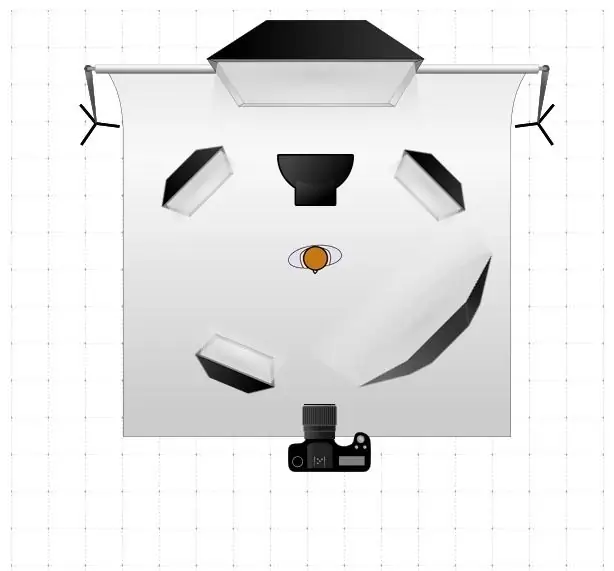
Es gibt ein Studio-Beleuchtungsschema für künstlerische Porträts namens"Rembrandtian" und ermöglicht es Ihnen, den Effekt der Dämmerung zu erzielen, aus dem das Gesicht deutlich sichtbar ist. Das Prinzip orientiert sich an Rembrandts Zeichnungen - er setzte seine Modelle in einer 3/4-Drehung von dem Fenster, aus dem direktes Licht fiel. Daher müssen wir die Softbox (nicht den Scheinwerfer!) so positionieren und können zusätzlich den Hintergrund leicht hervorheben

Weicher Dunst
Am häufigsten wird diese Art der Beleuchtung für intime Aufnahmen von halbnackten Modellen oder für ein thematisches Fotoshooting gewählt, bei dem sehr weiches und diffuses Licht erforderlich ist. Genau diesen Effekt erzielt der Fotograf mit Hilfe zweier riesiger Softboxen, die jeweils diagonal hinter dem Model platziert werden, das Licht wird nach hinten gelenkt. Vor dem Modell ist außerdem eine Lichtquelle installiert, die durch einen reflektierenden Schirm gedämpft wird. Am besten fotografieren Sie mit einem solchen Beleuchtungsschema vor dunklem Hintergrund und verwenden Hilfseffekte in Form von Rauch, vereinzelten Spritzern, Seifenblasen etc.

Im hellen Scheinwerferlicht
Einige Profis nennen dieses Studiobeleuchtungsschema "Gamine", weil das Hauptkriterium für die Bewertung eine übermäßige Helligkeit ist. Außerdem werden die Lichtstrahlen aller Quellen maximal auf das Modell fokussiert, während der Hintergrund praktisch unbeaufsichtigt bleibt. Zwei direkt strahlende Lampen beleuchten den Rücken der posierenden Person, ein Scheinwerfer blickt ihn frontal an, leicht gedämpft durch einen Schirm oder eine Softbox. Mit dieser Lichtposition werden das Foto, das Gesicht des Modells, die Elemente der Kleidung unglaublichausdrucksvoll. Daher sollten Sie sich sorgfältig auf das Fotoshooting vorbereiten und das Bild perfekt machen.
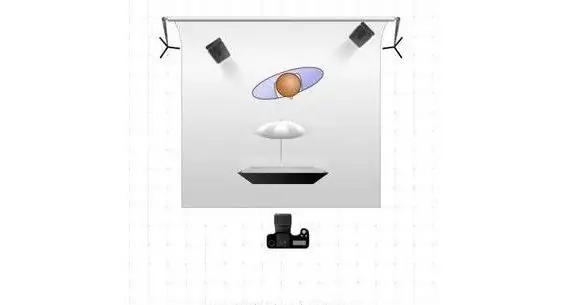
Das Spiel von Licht und Schatten
Wenn Sie ausdrucksstarke, gestochen scharfe, saftige Fotos wollen, aber nicht auf maximale Helligkeit aus sind, dann ist dieses Zwei-Quellen-Studiolicht-Setup perfekt. Der erste ist rechts vom Fotografen montiert und beleuchtet die Szene diagonal. Es ist wichtig, dass es auf die Höhe des menschlichen Wachstums oder etwas höher angehoben wird. Die zweite Quelle befindet sich in der hinteren gegenüberliegenden Ecke - dies ist eine kleine Softbox. Ein weiterer wichtiger Punkt ist der Reflektor. Es sollte die Rolle einer geraden Wand spielen, die rechts vom Fotografen entlang der Bühne verläuft. Das Ergebnis sind lebendige, originelle Aufnahmen, die sowohl das Model als auch ihren Schatten enth alten.
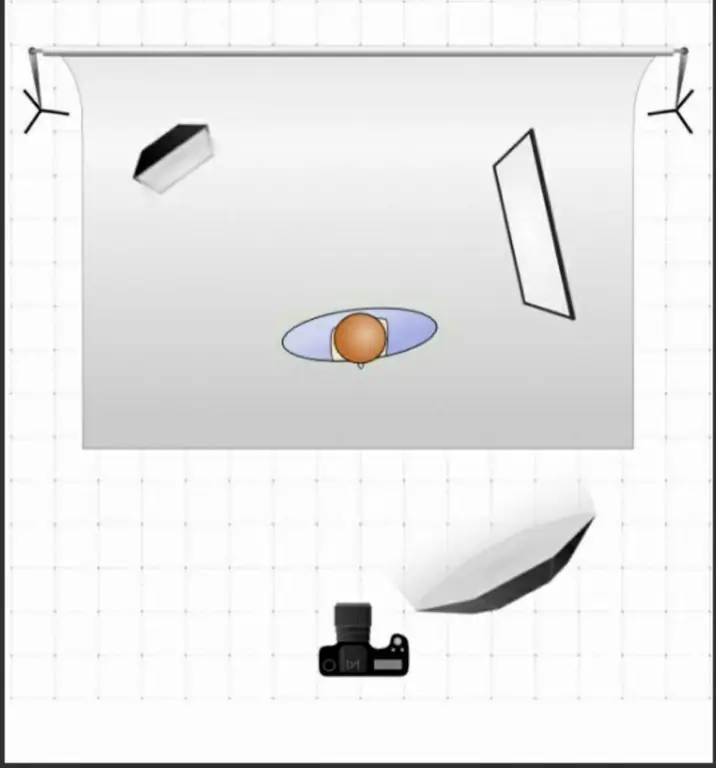
Silhouetten-Shooting
Wenn Sie sich ausschließlich auf die Figur des Modells konzentrieren und nicht die Details ihres Gesichts oder ihrer Kleidung sehen müssen, benötigen Sie höchstwahrscheinlich ein Silhouettenschema für die Studiobeleuchtung. Ganz einfach: Du stellst hinter dem Model zwei Scheinwerfer so auf, dass sie ihren Rücken schräg beleuchten und verdunkelst sie mit schwarzen Schirmen. Wenn Sie überhaupt keine Gesichter sehen möchten, dimmen Sie alle anderen Lichter im Studio, auch diejenigen, die nicht in der Szene sind. Wenn Sie dennoch einen weichen Strahl benötigen, der das Gesicht beleuchtet, installieren Sie eine kleine Softbox, die das Modell diagonal vom Vordergrund hervorhebt.
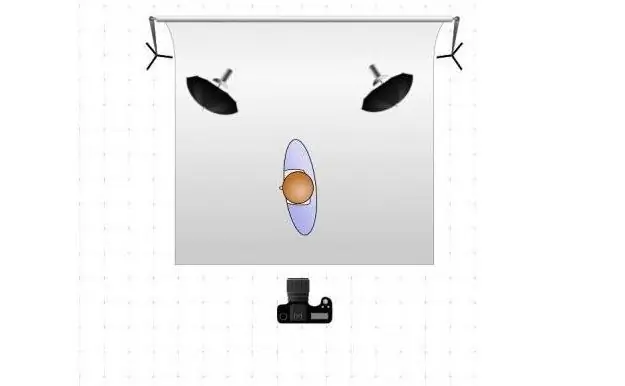
Kommt aus der Dunkelheit
Aufnahme auf schwarzem Hintergrund -sehr kompliziert. Damit die Aufnahmen gut gelingen (insbesondere bei Portraits), greift man am besten auf Loop-Lighting zurück. Seine Essenz liegt darin, dass eine einzige Lichtquelle verwendet wird, die sich auf der Höhe des menschlichen Wachstums befindet und in einem Winkel von etwa 35 o auf das Gesicht "schaut".
Wenn Sie einen hellen Scheinwerfer wählen, werden die Fotos kontrastreich - der Hintergrund ist nicht sichtbar, er wird tiefschwarz und die Silhouette des Modells wird sehr hell und klar und ausdrucksstark. Wenn Sie das Licht dimmen oder eine Softbox verwenden, wird der Hintergrund leicht hervorgehoben, das Modell wirkt weicher, Schärfe und Kontrast verschwinden. Es ist äußerst wichtig, die Position des Schattens von der Nase aus zu erfassen - dies ist der Schlüssel zur richtigen Installation des Scheinwerfers. Der Schatten sollte nicht die gesamte Wange ausfüllen, er sollte klein sein und leicht nach unten gerichtet sein. Sie können das Licht der Lampe basierend auf den Merkmalen des Modells einstellen. Hauptsache, Sie fangen diese Funktion ein.

Schmetterlingsbeleuchtung
Nun, das ist ein Lieblingstrick aller Fotografen, die für Modemagazine und Kataloge fotografieren. Das Model auf dem Foto ist sehr ausdrucksstark, aber nicht zu hell, der Hintergrund ist hervorgehoben, aber nicht blendend.
Die Lichtquelle befindet sich also direkt hinter dem Fotografen, sie "schaut" frontal auf die Szene, ist aber gleichzeitig etwas höher als die menschliche Körpergröße. Die Hauptzeichen sind "Schmetterlinge" - dünne Schatten von Nase und Kinn, die deutlich nach unten fallen. Das Schema ist sowohl einfach als auch sehr schön.

Innenaufnahmen
Das Aufstellen des Lichts und die Auswahl der richtigen Quellen auf einem einfachen Hintergrund aus Normalpapier ist eine sehr einfache Aufgabe. Aber wenn Sie dasselbe tun müssen, nur vor dem Hintergrund von Möbeln, Accessoires und anderen dekorativen Elementen, wird alles komplizierter.
Wie sollte die Studiobeleuchtung in einem Innenstudio aussehen und wie kann man ein Model vor dem Hintergrund verschiedener Objekte kompetent fotografieren? Die Hauptregel ist, keine hellen Scheinwerfer zu verwenden. Das Licht wird durch Schirme oder Reflektoren und Softboxen gedimmt. Darüber hinaus hängt die Anordnung der Lichtquellen vom Stil und den Vorlieben ab. Sie können den ganzen Raum mit Licht füllen - dann werden die Bilder sehr hell, jedes Detail wird sichtbar - sowohl auf dem Modell als auch im Innenraum. Wenn der Raum als sekundärer Hintergrund dient, verwenden Sie eine Schmetterlingsbeleuchtung oder ein Schleifenschema.
Familienfotosession
Studiobeleuchtungsschemata zum Fotografieren der ganzen Familie werden in der Regel aus den hellsten und hellsten ausgewählt. Halbtöne, Licht- und Schattenspiele und natürlich Silhouettenbeleuchtung haben keinen Platz. In den meisten Fällen werden Studiobeleuchtungsschemata für ein Familienfoto-Shooting unter dem „Schutz“von Softboxen erstellt. Die größeren sind schräg nach hinten gesetzt, die kleineren beleuchten die Gesichter vorne und etwas darüber - so etwas wie ein „Schmetterlingseffekt“, aber heller. An den Seiten und am Boden befinden sich oft längliche Lichtquellen - damit Boden und Beine der posierenden Personen nicht im Schatten bleiben.

Schlussfolgerung
Das Licht einzustellen ist eine heikle Angelegenheit. Nicht jeder Fotograf kann diese Aufgabe bewältigen und sich auf ein bestimmtes Modell einstellen. Aber wenn Kontakt besteht, dann können Sie Spotlights und Softboxen intuitiv anordnen und sich dabei auf den Stil des Fotoshootings, auf die Vorlieben des Models und auf seine Eigenschaften konzentrieren. Scheuen Sie sich nicht zu experimentieren und sich neue Variationen einfallen zu lassen.
Empfohlen:
Süßes Design, was ist das? Beispiele für Neujahrskompositionen
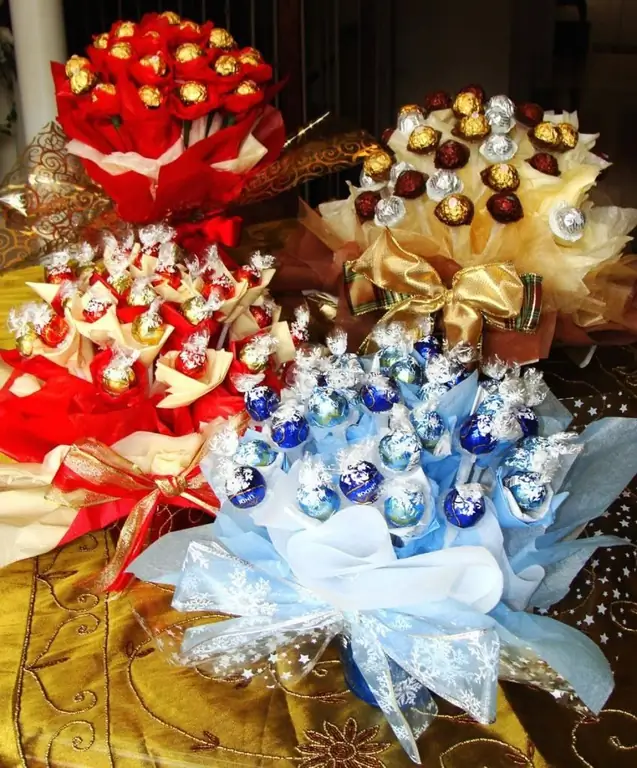
Vielleicht haben Sie den Ausdruck "süßes Design" schon einmal gehört, aber Sie wissen immer noch nicht, was es ist. Tatsächlich nennt man diesen schönen Ausdruck die in letzter Zeit beliebten Kompositionen aus verschiedenen Süßigkeiten, Bonbons und Wellpappe. Als zusätzliche Dekoration können andere Materialien verwendet werden, z. B. Blumenband, Kunstmoos, Perlen
Ideen für ein Fotoshooting zu Hause: Arten von Fotos, Beispiele, die Verwendung von zusätzlichem Zubehör und improvisierte Hausmittel
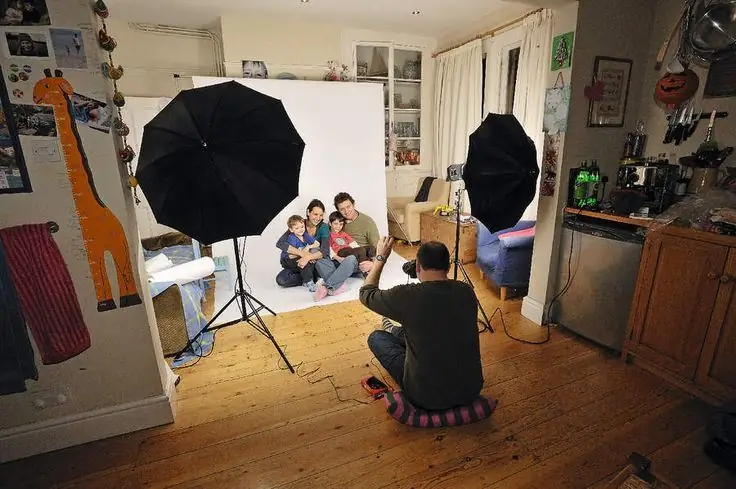
Die Idee für ein Fotoshooting zu Hause ist nur ein kleiner Teil einer großen Aufgabe. Sie können die für Sie bequemste Position wählen und dabei den Innenraum und die Position zusätzlicher Gegenstände beim Fotografieren berücksichtigen. Sie entscheiden, welche Emotionen Sie ausdrücken möchten und wo das Foto am besten aussehen wird. Dieser Artikel hilft Ihnen, die richtige Entscheidung zu finden oder zu treffen, eine Wahl zu treffen
Wie man eine Lünette mit Bändern flechtet: Techniken für Anfänger und Beispiele mit Fotos

Wie man ein Stirnband mit Bändern verziert. Beschreibung der Techniken mit einem Tape oder zwei Tapes. Was ist die Kanzashi-Technik und wie können Sie damit das Stirnband mit Bändern flechten? Mit Blumen geschmückte Stirnbänder
Origami-Schemata für ein persönliches Tagebuch: Beispiele für die Gest altung von Notizen

Ein Tagebuch ist das persönliche Territorium einer Person, es kann verwendet werden, um wichtige Momente und Ereignisse im Leben aufzuzeichnen, denn mit der Zeit verblassen Erinnerungen und Emotionen werden vergessen. Wer ein Tagebuch führt, sollte an dessen farbenfrohe Gest altung denken. Einfache Origami-Schemata und Fantasie können dabei helfen
Plots und Beispiele für Kreuzstich in der Natur

Stickerei gilt als beliebte Art der Handarbeit, da sie verschiedene Techniken kombiniert, um originelle Dinge zu schaffen. Beim Kreuzstich in der Natur finden Sie interessante Plots sowohl für Gemälde als auch für die Erstellung stilvoller Accessoires für den Innenraum
